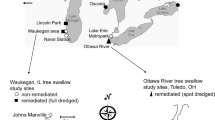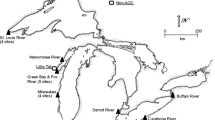Abstract
In 2008 and 2009, dredge material from the Mississippi River in Pool 8 south of Brownsville, Minnesota was used to construct nearby islands. Chemical analysis of sediment in 2001 and 2002 in the area to be dredged indicated detectable concentrations of organic and inorganic contaminants. Tree swallows (Tachycineta bicolor), whose diet is mainly aquatic invertebrates, were used to evaluate contaminant exposure in both the dredged and newly created habitat. Organic and inorganic contaminant data were collected from tree swallows in 2007 through 2010 at one study site near the dredging operation, a reference study site upriver from the dredging activity, one study site down river from the dredging activity, and one study site on a newly created island (2009 and 2010 only). Organic and element concentrations were at background levels in all samples. Polychlorinated biphenyl and p,p′-dichlorodiphenyldichloroethylene concentrations in tree swallow nestlings decreased at all study sites over the period 2007 to 2010 including the island study site between 2009 and 2010. Element concentrations in tree swallow livers for the non-island study sites did not show a trend among years in relation to the dredging. Selenium concentrations at the newly created island were higher and cadmium concentrations were lower in 2010 than 2009. Hatching success of eggs in successful nests was not associated with dredging activities.




Similar content being viewed by others
References
Blancher, P. J., & McNicol, D. K. (1991). Tree swallow diet in relation to wetland acidity. Canadian Journal of Zoology, 69, 2629–2637.
Brooks, J. M., Wade, T. L., Atlas, E. L., Kennicutt II, M. C., Presley, B. J., Fay, R. R., Powell, E. N., & Wolff, G. (1989). Analysis of bivalves and sediments for organic chemicals and trace elements. Third Annual Report for NOAA's National Status and Trends Program, Contract 50-DGNC-5-00262.
Custer, C. M. (2011). Swallows as a sentinel species for contaminant exposure and effect studies. In J. E. Elliott, C. A. Bishop, & C. A. Morrissey (Eds.), Wildlife ecotoxicology: forensic approaches (pp. 45–91). New York: Springer.
Custer, C. M., Custer, T. W., Allen, P. D., Stromborg, K. L., & Melancon, M. J. (1998). Reproduction and environmental contamination in tree swallows nesting in the Fox River drainage and Green Bay, Wisconsin, USA. Environmental Toxicology and Chemistry, 17, 1786–1798.
Custer, C. M., Custer, T. W., Dummer, P. M., & Munney, K. L. (2003a). Exposure and effects of chemical contamination on tree swallows nesting along the Housatonic River, Berkshire County, Massachusetts, USA, 1998–2000. Environmental Toxicology and Chemistry, 22, 1605–1621.
Custer, C. M., Custer, T. W., Archuleta, A. S., Coppock, L.C., Swartz, C. D., & Bickham, J. W. (2003b). A mining impacted stream: Exposure and effects of lead and other trace elements on tree swallows (Tachycineta bicolor) nesting in the upper Arkansas River basin, Colorado. In Hoffman et al. (Eds), Handbook of Ecotoxicology, vol. 2 (pp. 787–812). Boca Raton: Lewis
Custer, C. M., Custer, T. W., & Hill, E. F. (2007a). Mercury exposure and effects on cavity-nesting birds from the Carson River, Nevada. Archives of Environmental Contamination and Toxicology, 52, 129–136.
Custer, T. W., Hines, R. K., Melancon, M. J., Hoffman, D. J., Wickliffe, J. K., Bickham, J. W., Martin, J. W., & Henshel, D. S. (1997). Contaminant concentrations and biomarker response in great blue heron eggs from 10 colonies on the upper Mississippi River, USA. Environmental Toxicology and Chemistry, 16, 260–271.
Custer, T. W., Custer, C. M., Dickerson, K., Allen, K., Melancon, M. J., & Schmidt, L. J. (2001). Polycyclic aromatic hydrocarbons, aliphatic hydrocarbons, trace elements and monooxygenase activity in birds nesting on the North Platte River, Casper, Wyoming, USA. Environmental Toxicology and Chemistry, 20, 624–631.
Custer, T. W., Dummer, P. M., Custer, C. M., Li, A. U., Warburton, D., Melancon, M. J., Hoffman, D. J., Matson, C. W., & Bickham, J. W. (2007b). Water level management and contaminant exposure to tree swallows nesting on the upper Mississippi River. Environmental Monitoring and Assessment, 133, 335–345.
Dunn, P. O., & Hannon, S. J. (1992). Effects of food abundance and male parental care on reproductive success and monogamy in tree swallows. Auk, 109, 488–499.
Eggleton, J., & Thomas, K. V. (2004). A review of factors affecting the release and bioavailability of contaminants during sediment disturbance events. Environment International, 30, 973–980.
Gebauer, M. B., & Weseloh, D. V. (1993). Accumulation of organic contaminants in sentinel mallards utilizing confined disposal facilities at Hamilton Harbour, Lake Ontario, Canada. Archives of Environmental Contamination and Toxicology, 25, 234–243.
Gerrard, P. M., & St. Louis, V. L. (2001). The effects of experimental reservoir creation on the bioaccumulation of methylmercury and reproductive success of tree swallows (Tachycineta bicolor). Environmental Science and Technology, 35, 1329–1338.
Hebert, C., Hobson, K., & Hutt, J. L. (2000). Changes in food web structure affect rate of PCB decline in Herring Gull (Larus argentatus) eggs. Environmental Science and Technology, 34, 1609–1614.
Heinz, G. H., & Stromborg, K. L. (2009). Further declines in organochlorines in eggs of red-breasted mergansers from Lake Michigan, 1977–1978 versus 1990 versus 2002. Environmental Monitoring and Assessment, 159, 163–168.
Hensler, G. L., & Nichols, J. D. (1981). The Mayfield method of estimating nesting success: a model, estimators and simulation results. Wilson Bulletin, 93, 42–53.
Howarth, D. M., Grant, T. R., & Hulbert, A. J. (1982). A comparative study of heavy metal accumulation in tissues of the crested tern, Sterna bergii, breeding near an industrial port before and after harbour dredging and ocean dumping. Australian Wildlife Research, 9, 571–577.
MacLeod, W. D., Brown, D. W., Friedman, A. J., Burrow, D. G., Mayes, O., Pearce, R. W., et al. (1985). Standard Analytical Procedures of the NOAA National Analytical Facility 1985–1986. Extractable Toxic Organic Compounds. 2nd Ed. U.S. Department of Commerce, NOAA/NMFS, NOAA Tech. Memo. NMFS F/NWRC-92.
Mayfield, H. (1961). Nesting success calculated from exposure. Wilson Bulletin, 73, 255–261.
Mayfield, H. (1975). Suggestions for calculating nest success. Wilson Bulletin, 87, 456–466.
McCarty, J. P., & Winkler, D. W. (1999). Foraging ecology and diet selectivity of tree swallows feeding nestlings. Condor, 101, 246–254.
Mengelkoch, J. M., Niemi, G. J., & Regal, R. R. (2004). Diet of the nestling tree swallow. Condor, 106, 423–429.
Quinney, T. E., & Ankney, C. D. (1985). Prey size selection by tree swallows. Auk, 102, 245–250.
Robertson, R. J, Stutchbury, B. J., & Cohen, R. R. (1992). Tree swallow (Tachycineta bicolor) In A. Poole, P. Stettenheim, & F. Gill (Eds), The Birds of North America, No. 11 (pp. 26). Philadelphia, PA: Academy of Natural Sciences
Sauer, J. R., & Williams, B. K. (1989). General procedures for testing hypotheses about survival or recovery rates. Journal of Wildlife Management, 53, 137–142.
Spears, B. L., Brown, M. W., & Hester, C. M. (2008). Evaluation of polychlorinated biphenyl remediation at a superfund site using tree swallows (Tachycineta bicolor) as indicators. Environmental Toxicology and Chemistry, 27, 2512–2520.
US Geological Survey. (1995). Contaminants in the Mississippi River, 1987–92. In R.H. Meade (Ed.), U.S. Geological Survey Circular 1133, 140pp.
Wade, T. L., Atlas, E. L., Brooks, J. M., Kennicutt, M. C., II, Fox, R. G., Sericano, J., Garcia, B., & DeFreitas, D. (1988). NOAA Gulf of Mexico status and trends program: trace organic contaminant distribution in sediments and oyster. Estuaries, 11, 171–179.
Weseloh, D. V., Moore, D. J., Hebert, C. E., de Siolla, S. R., Braune, B. M., & McGoldrick, D. J. (2011). Current concentrations and spatial and temporal trends in mercury in Great Lakes herring gull eggs, 1974–2009. Ecotoxicology, 20, 1644–1658.
White, D. H., & Cromartie, E. (1985). Bird use and heavy metal accumulation in waterbirds at dredge disposal impoundments, Corpus Christi, Texas. Bulletin of Environmental Contamination and Toxicology, 34, 295–300.
Wiener, J. G., Jackson, G. A., May, T. W., & Cole, B. P. (1984). Longitudinal distribution of trace elements (As, Cd, Cr, Hg, Pb, and Se) in fishes and sediments in the Upper Mississippi River. In: J. G. Wiener, R. V. Anderson, & D. R. McConville (Eds.), Contaminants in the Upper Mississippi River. Proceedings of the 15th Annual Meeting of the Mississippi River Research Consortium (pp. 139–170). Stoneham, MA: Butterworth.
Wiener, J. G., Krabbenhoft, D. F., Heinz, G. F., & Scheuhammer, A. M. (2003). Ecotoxicology of mercury. In D. J. Hoffman, B. A. Rattner, G. A. Burton Jr., & J. Cairns Jr. (Eds.), Handbook of ecotoxicology (Vol. 2, pp. 409–463). Boca Raton: Lewis.
Wiener, J. G., & Sandheinrich, M. B. (2010). Contaminants in the Upper Mississippi River: historic trends, responses to regulatory controls, and emerging concerns. Hydrobiologia, 640, 49–70.
Acknowledgments
We thank Dwayne Houdek for logistical assistance; Pete Boma, Jennifer Herner-Thogmartin, and Max Weber for field assistance; the Iowa, Chicago and Eastern Railroad for permission to work on their property; and the Upper Mississippi River National Wildlife and Fish Refuge for permission to work on their property. This study was funded through On-Refuge Contaminants Investigations of the US Fish and Wildlife Service. Any use of trade, product, or firm names is for descriptive purposes only and does not imply endorsement by the US Government.
Author information
Authors and Affiliations
Corresponding author
Electronic supplementary material
Below is the link to the electronic supplementary material.
ESM 1
(DOC 164 kb)
Rights and permissions
About this article
Cite this article
Custer, T.W., Dummer, P.M., Custer, C.M. et al. Dredging and contaminant exposure to tree swallows nesting on the upper Mississippi River. Environ Monit Assess 185, 9043–9053 (2013). https://doi.org/10.1007/s10661-013-3234-z
Received:
Accepted:
Published:
Issue Date:
DOI: https://doi.org/10.1007/s10661-013-3234-z




